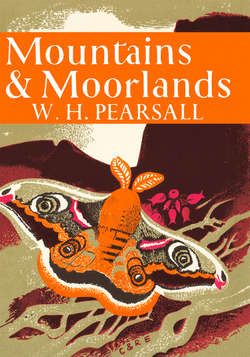Читать книгу Mountains and Moorlands - W. Pearsall H. - Страница 21
MULL AND MOR
ОглавлениеIn some respects the quantitative effects of leaching are similar to those produced by saturation with water—namely, a great reduction in the activity of the soil organisms. The qualitative effects of leaching on the soil micro-flora are, however, even more pronounced, and so much so that it is customary to give a special name, mor, to the peaty humus formed in leached soils, in order to distinguish it from the more fertile leaf-mould (or mull) typically associated with fertile forest soils. While mor is chemically different, as we shall see later, its most noticeable distinguishing features are biological and are easily recognised. There is a vegetation dominated by plants such as heathers, bilberry and wavy hair-grass (Deschampsia flexuosa), and normally an absence of earthworms. Usually, too, no tree seedlings are to be found except those of pine and birch. Moreover, leguminous plants such as clover are absent, while suitable tests show that the soil lacks nitrogen-fixing bacteria or, at least, effective strains of this type. Finally, the mor soil has a high and characteristic degree of acidity (see here), normally marked by a pH value below 3·8. It yields low proportions of ammonia, while nitrates are absent. It is evident, indeed, that in mor the rate and extent of nitrogen transformation is greatly reduced, presumably by the reduction in the numbers of suitable bacteria. It is in fact usually considered that the micro-flora of this type of humus contains few bacteria and is mainly one of moulds and of other fungi like actino-mycetes and basidiomycetes, but the evidence is far from conclusive owing to the difficulties of identifying these microscopic organisms in a dark-coloured peaty soil. Moulds and other fungi are generally more tolerant of acidity than are many soil bacteria, which fail to develop either in acid or in lime-deficient maedia.
It may be useful to add here a note on the soil animals which are more characteristic of mor soils. They include certain mites, the larval stages of two-winged flies (Diptera), click-beetles (Elaterideae), and often centipedes and predatory beetles. In contrast, earthworms, snails and millipedes are particularly characteristic of good forest leaf-moulds.
Mor soils in the strict sense in Britain are confined to the acid types of soil (normally with a podsol profile) distinguished in an earlier section. Characteristic mull soils are found on lime-deficient as well as on lime-saturated soils. More strongly base-deficient soils generally have humus of this type which produces nitrates (for example) rather slowly and may, at times, be somewhat intermediate in other respects.
The third factor which must profoundly affect the properties of the soil organic matter is the low temperature of many upland habitats. There can be no doubt that the soil organisms, like other forms of life, have their activity greatly reduced by low temperature. Hence the rate of decomposition of soil organic matter declines very rapidly in cold climates and peat accumulates, for the rate at which higher and larger plants form organic matter is less affected by low temperature, depending rather on the carbon-dioxide content of the air and on light. So far as I am aware, little or no investigation of the characters of this peaty material has been attempted, and the matter would probably be most easily examined by studying the rather peaty humus that accumulates on and among the mountain-top detritus. This is usually a black and easily crumbling peat generally containing a good deal of sand. It differs very markedly from a typical mor, such as that from below heather, for example, which is generally red-brown in colour, closer in texture and more acid. On the other hand, both soil-types have certain features in common such as some resemblance in fauna, e.g. scarcity of worms and frequency of dipterous larvae. There is also a good deal of evidence, though it is mainly derived from studies in arctic regions, that the bacterial processes affecting the accumulation of nitrogen (by fixation) and its liberation in forms suitable for plant food are especially curtailed by low temperature. As a result, there is certainly a notable scarcity of soluble forms of nitrogen in mountain-top habitats, though the limited available evidence suggests that this scarcity is not as severe as is the case in either bog-peat or acid mor. In my own observations, about half the tested soils have given traces of nitrates in late summer, and higher proportions might possibly be observed at other times. The interesting feature of the samples of humus from among mountain-top detritus has been their high proportion of nitrogen, usually 4 per cent of the total humus content. This does in fact suggest that there has been a rather slow decomposition of nitrogenous materials, though this is not the only possible explanation. The following short table summaries a few values for the nitrogen proportions of characteristic humus types.
Table 6 NITROGEN CONTENT OF DIFFERENT SOIL TYPES AS PER CENT OF THEIR HUMUS CONTENTS
| Soil | Vegetation | Percentage |
|---|---|---|
| Mountain-top detritus (2800–3000 ft.) | Moss-lichen grassland (see p. 85) | 3·6–4·0 |
| Mor over podsol (700–1000 ft.) | Heather-moor | 1·0–2·0 |
| Upland bog peat (1200–1500 ft.) | Mixed-bog with bog-moss (p. 147–152) | 1·7–2·4 |
| Flushed brown earth with mull | Oak-wood with soft-grass | 3·1–3·5* |
This table brings out the low nitrogen content of the upland bog-peats and mor when contrasted with the mull humus of an oak-wood. Still more evident would this contrast be if we included the humus of lowland woods or of agricultural soils. The well-decomposed humus of a fertile arable soil, such as a wheat field, has commonly a nitrogen content of between 4·5 and 5 per cent, a value which seems to be a characteristic of soils in the lowland north temperate climate.
